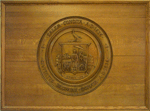Crucible (book)
The Crucible was published in 1953 by Arthur Miller. (October 17, 1915 – February 10, 2005)
Miller bases the play on the historical account of the Salem witch trials. In particular he focuses on the discovery of several young girls and a slave playing in the woods, conjuring — or attempting to conjure — spirits from the dead. Rather than suffer severe and inevitable punishment for their actions, the girls accused other inhabitants of Salem of practicing witchcraft. Ironically, the girls avoided punishment by accusing others of the very things of which they were guilty. This desperate and perhaps childish finger-pointing resulted in mass paranoia and an atmosphere of fear in which everyone was a potential witch. As the number of arrests increased, so did the distrust within the Salem community. A self-perpetuating cycle of distrust, accusation, arrest, and conviction emerged. By the end of 1692, the Salem court had convicted and executed nineteen men and women.
In The Crucible, Miller likened the situation with the House Un-American Activities Committee to the witch hunt in Salem in 1692. The play opened at the Martin Beck Theatre on Broadway on January 22, 1953. Though widely considered only somewhat successful at the time of its release, today The Crucible is Miller's most frequently produced work throughout the world.
